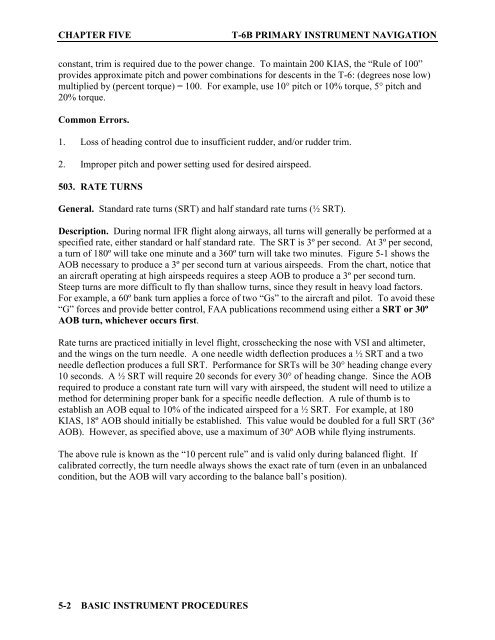Flight Training Instruction - Cnatra - U.S. Navy
Flight Training Instruction - Cnatra - U.S. Navy
Flight Training Instruction - Cnatra - U.S. Navy
You also want an ePaper? Increase the reach of your titles
YUMPU automatically turns print PDFs into web optimized ePapers that Google loves.
CHAPTER FIVE T-6B PRIMARY INSTRUMENT NAVIGATION<br />
constant, trim is required due to the power change. To maintain 200 KIAS, the “Rule of 100”<br />
provides approximate pitch and power combinations for descents in the T-6: (degrees nose low)<br />
multiplied by (percent torque) = 100. For example, use 10° pitch or 10% torque, 5° pitch and<br />
20% torque.<br />
Common Errors.<br />
1. Loss of heading control due to insufficient rudder, and/or rudder trim.<br />
2. Improper pitch and power setting used for desired airspeed.<br />
503. RATE TURNS<br />
General. Standard rate turns (SRT) and half standard rate turns (½ SRT).<br />
Description. During normal IFR flight along airways, all turns will generally be performed at a<br />
specified rate, either standard or half standard rate. The SRT is 3º per second. At 3º per second,<br />
a turn of 180º will take one minute and a 360º turn will take two minutes. Figure 5-1 shows the<br />
AOB necessary to produce a 3º per second turn at various airspeeds. From the chart, notice that<br />
an aircraft operating at high airspeeds requires a steep AOB to produce a 3º per second turn.<br />
Steep turns are more difficult to fly than shallow turns, since they result in heavy load factors.<br />
For example, a 60º bank turn applies a force of two “Gs” to the aircraft and pilot. To avoid these<br />
“G” forces and provide better control, FAA publications recommend using either a SRT or 30º<br />
AOB turn, whichever occurs first.<br />
Rate turns are practiced initially in level flight, crosschecking the nose with VSI and altimeter,<br />
and the wings on the turn needle. A one needle width deflection produces a ½ SRT and a two<br />
needle deflection produces a full SRT. Performance for SRTs will be 30° heading change every<br />
10 seconds. A ½ SRT will require 20 seconds for every 30° of heading change. Since the AOB<br />
required to produce a constant rate turn will vary with airspeed, the student will need to utilize a<br />
method for determining proper bank for a specific needle deflection. A rule of thumb is to<br />
establish an AOB equal to 10% of the indicated airspeed for a ½ SRT. For example, at 180<br />
KIAS, 18º AOB should initially be established. This value would be doubled for a full SRT (36º<br />
AOB). However, as specified above, use a maximum of 30º AOB while flying instruments.<br />
The above rule is known as the “10 percent rule” and is valid only during balanced flight. If<br />
calibrated correctly, the turn needle always shows the exact rate of turn (even in an unbalanced<br />
condition, but the AOB will vary according to the balance ball’s position).<br />
5-2 BASIC INSTRUMENT PROCEDURES
















